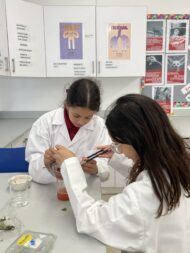As part of a recent science fair project, I had the opportunity to explore the fascinating world of natural dyes. Inspired by the colors of nature and the sustainable potential of plant-based dyes, I set out to experiment with common kitchen ingredients — strawberries, blueberries, and turmeric — to see how they could transform plain fabric into vibrant works of art. Not only did I uncover the magic of these ingredients, but I also discovered something unexpected and valuable: the lasting power of turmeric.
The Natural Dyeing Process
The process began with simple cotton fabric and a bit of preparation. Each dye source needed to be carefully extracted to release its rich pigments.
- Strawberries: I started by mashing fresh strawberries and boiling them to create a concentrated dye. Strawberries are known for their rich red color, and I was curious to see how this would translate onto fabric.
- Blueberries: Similarly, I crushed blueberries and simmered them in water, hoping to capture their deep purple-blue hues. Blueberries are rich in anthocyanins, the pigments responsible for their color, which made them an interesting contender for this project.
- Turmeric: Known for its vibrant yellow-orange color, turmeric is a spice that’s often used in cooking. To extract the dye, I dissolved turmeric powder into water and heated it, creating a golden-yellow dye.
Once the dye solutions were prepared, I submerged small pieces of fabric into each of the mixtures. The cotton absorbed the dyes quickly, and I was left with three vibrant pieces of fabric: one in shades of red from strawberries, another in purple from blueberries, and a third in golden yellow from turmeric.
The Science Behind the Colors
Each of these natural dyes comes from different sources and behaves differently when applied to fabric. Here’s a quick look at why each dye worked as it did:
- Strawberries: The high acidity of strawberries may help release their color when boiled, but these dyes tend to be less stable. The color can fade easily, especially when exposed to sunlight or washing.
- Blueberries: Similarly, the anthocyanins in blueberries can stain fabric beautifully, but the color can be prone to fading or changing over time, especially with washing.
- Turmeric: Turmeric, however, has a unique property. Curcumin, the compound responsible for its color, bonds strongly with the fabric, making it far more resistant to fading. This is why turmeric has long been used in traditional fabric dyeing across various cultures.
The Wash Test: Turmeric’s Lasting Power
After allowing the fabrics to dry, the moment of truth came — the wash test.
I carefully washed each piece of fabric by hand to observe how the colors held up:
- Strawberries: The fabric dyed with strawberries showed some color loss after just one wash. The once-vibrant red hues had faded to a softer, pale pink.
- Blueberries: The blueberry-dyed fabric also experienced some fading, though not as dramatically as the strawberries. The fabric retained a slight bluish tint, but the deep color had softened significantly.
- Turmeric: To my surprise, the turmeric-dyed fabric showed almost no color loss after washing. The golden-yellow color remained vivid and strong, proving to be the most durable of the three natural dyes. It was clear that turmeric’s ability to bond with the fabric made it an excellent option for long-lasting, vibrant colors.
Why Experiment with Natural Dyes?
The results of this experiment highlight the potential of natural dyes to bring sustainable, eco-friendly color to our everyday lives. Using fruits, spices, and plants to dye fabric not only connects us to nature, but it also encourages a more environmentally conscious way of creating and crafting.
- Sustainability: Unlike synthetic dyes, which can be harmful to the environment, natural dyes are biodegradable and often require fewer resources to produce. They are a great option for eco-conscious individuals who want to make a positive impact on the planet.
- Creativity: Natural dyes offer a beautiful, earthy palette that can be used in a variety of creative projects. Whether it’s upcycling old clothing, creating fabric for quilting, or designing unique pieces of art, natural dyes add a personal touch to every project.
- Educational Value: This experiment not only taught me about the science of dyes but also about sustainability, chemistry, and the importance of making thoughtful, eco-friendly choices.
Conclusion
Experimenting with natural dyes was an exciting and rewarding experience. Strawberries, blueberries, and turmeric each produced beautiful colors, but turmeric proved to be the star of the show, maintaining its vibrant yellow hue even after washing. This project opened my eyes to the power of nature and how simple ingredients from the kitchen can create long-lasting, stunning fabrics.
Natural dyes offer a fun, educational, and eco-friendly way to explore the world of colors while helping to reduce our environmental footprint. Whether you’re looking to dye clothes, create art, or simply experiment with new techniques, I encourage you to give natural dyeing a try — you may be surprised by the results!













Follow R&S UAE